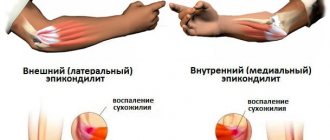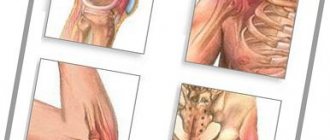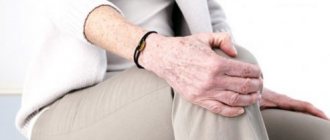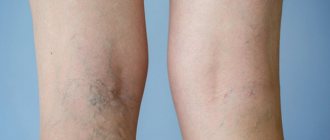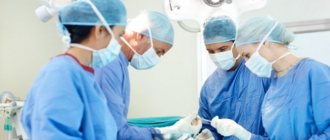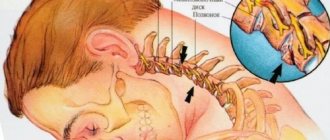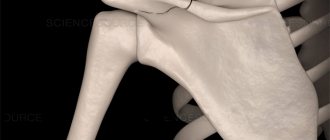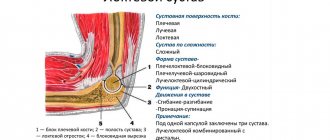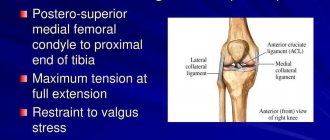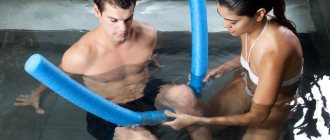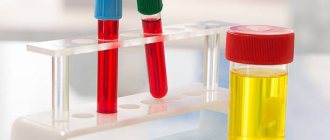What is a crunch in the knees?
First you need to understand what the knee joint is.
It is the site of articulation of the femur and tibia. At the junction, the bones are covered with cartilage tissue, between which there is an elastic meniscus, and the spaces between the hard surfaces are filled with synovial fluid, which reduces the pressure and friction of hard surfaces against each other.
This connection system with bone fixation using ligaments, muscles and tendons provides the best mobility.
However, with increased loads on the joint and cartilage tissue, and with various chronic, infectious and other diseases, the cartilage tissue can wear out, and the surface can be slightly deformed. The relief formed during deformation becomes the cause of the formation of noise and clicks during movements.
However, in some cases, crunching in the knees during flexion and extension may occur due to the formation of air bubbles in the synovial fluid and for a number of other reasons caused by active physical activity.
If the sounds are periodic and are not accompanied by painful sensations, then you should not worry about it in advance.
During extension
An alarming symptom is a crunching sound that occurs when the leg is extended, especially periodically repeated when walking without additional physical activity.
If the crunch is accompanied by aching, pulling or acute physical pain, then this is an additional symptom of damage or wear of cartilage tissue.
Over time, the disease can progress if appropriate measures are not taken and the situation will only get worse in the future.
As a rule, damage to cartilage tissue is caused by inflammatory processes and various arthrosis of the knee joint. Infectious arthrosis can be treated quite easily and quickly; age-related ones can be treated with diets, reasonable physical activity and medications. The main thing is to seek help in time.
When squatting
The appearance of clicks when squatting can have either a bad meaning or mean nothing at all. It all depends on the frequency of recurrence of the symptom and the accompanying sensations.
If clicks are rarely heard, then most likely everything is normal or you just need to adjust your physical activity. If the clicks are constant and the sounds are accompanied by pain, then this is a symptom of wear of the cartilage tissue.
Do an experiment: do several sets of 5-10 squats, if the sounds are repeated and cause discomfort during each set, then this is a problem.
If they occur only for the first time at the beginning of physical activity, then for now you can not worry about health problems and monitor your own physical form.
Physiological causes of crunching
Special attention should be paid to the crunch, which is not associated with pathological processes in the joint, there is no pain syndrome and no signs of inflammation, the knee has a normal appearance, without swelling of the knees and redness.
Orthopedic doctor Andrey Sergeevich Litvinenko comments:
The hard articular surfaces of the bones, shifting relative to each other, release bubbles in a liquid medium with dissolved gas. Scientists have found that synovial fluid contains up to 14% carbon dioxide. With sudden movements, the carbon dioxide bubbles do not have time to dissolve in the liquid and collapse, producing a sound resembling a crunch.
| Doctor examining patient's knee when clicking |
Sign up for treatment
Crunching in the knees when straightening without pain
Why does the knee crunch when extending, and is this necessarily a symptom of the disease? In practice, this is far from true, and even a healthy joint can make sounds. The main difference is the presence or absence of painful sensations accompanying the sound.
If the crunch occurs without pain, then its cause is:
Crossing of ligaments and subsequent putting into place - elastic ligaments can regularly shift to a safe distance and, when restoring their position, produce a characteristic sound that is mistakenly attributed to the joint;
Ligament overlap is the same problem as with tendons. It is not a pathology and does not require treatment;
The penetration of the synovial membrane between the cup and the thigh is also not a pathology; it occurs due to slight twisting of the leg during awkward movements.
Carefully analyze your own feelings if your knees begin to creak, this will allow you to promptly identify an unpleasant and serious disease and begin treatment or relief of symptoms.
Why do teenagers' knees crack?
A crunch in the knee during extension in a teenager can occur for various reasons. The most common of them:
Congenital defects - abnormalities in the structure of the joint or bone tissue;
Increased elasticity of connective tissues - this symptom often occurs in adolescence during the formation of body tissues. Due to the increased elasticity of the ligaments, a slight displacement of the joint may occur, accompanied by a crunch when returning to its place;
Injuries – after sprains or ruptures of ligaments and tendons, severe dislocations, this pathology may be observed for some time, which resolves over time;
Excessive loads - spend up to 4-5 hours at school in one sitting position, most of the load falls on the knees, as a result this can lead to mild inflammatory processes, fatigue of muscles, ligaments, tendons.
Most of the reasons are relatively safe, and with the right exercise regimen and care, the crunch may go away. In adolescence, this symptom rarely indicates any serious pathologies.
But if it occurs regularly, it is still recommended to be examined by a doctor. In adolescence, when bone and other tissues continue to develop, timely detection of pathologies and anomalies will help avoid more serious problems in the future.
Diagnostics
To adequately assess the functioning of the joints, a thorough diagnostic examination is necessary, since clicks can be the consequences of various causes that require appropriate therapy. It should be borne in mind that the symptoms may be similar to each other.
Most often, people who have crossed the threshold of forty years complain of a crunch in the knee, which is due to degenerative age-related changes occurring in the joint structures. In addition to crunching, patients complain of discomfort, morning stiffness in the joint and the presence of pain.
First of all, the doctor collects anamnestic data about the patient and the reasons that caused this condition, after which a visual examination, auscultation (listening) and palpation (feeling) of the affected joint is carried out. Next, the volume of motor activity in the knee joints is determined.
Studying the range of motion in the knee joint using an inclinometer
When collecting anamnesis, special attention is paid to the possibility of injury, as well as the presence of chronic diseases of the musculoskeletal system. In addition, it is important to clarify the patient’s professional activity, since a similar condition often occurs in professional athletes, as well as people whose profession involves frequent lifting of weights.
An external examination may reveal the following pathological symptoms:
- tumor at the site of localization of the inflammatory process;
- possible hematoma formation;
- various joint deformities;
- symmetry of pathological manifestations;
- damage to soft tissues and skin near the site of inflammation.
On palpation, crepitus may be clearly felt in the knee, especially if the palm is placed on the front of the knee while simultaneously bending it. In addition, palpation makes it possible to determine the presence of fluid in the joint cavity, as well as pathological deformations and displacement of the joint during dislocations and fractures. During auscultation, the patient is asked to perform passive or active movement of the limb, which leads to the appearance of clicks and crunching.
For a more accurate assessment of the range of movements, active movements that are performed independently by the patient are first assessed, and then those performed with medical assistance. When measuring with a goniometer (special device), the leg must be straightened.
To confirm a preliminary diagnosis, the following studies may be prescribed:
Radiography
As a rule, in most cases, radiography is quite sufficient to identify pathological changes in the joint, since the image clearly shows a fracture, cracks, inflammatory processes and degenerative disorders. In the case when a sharpening and elongation of the intercondylar eminence is noted on the x-ray image in 2 projections, this indicates the active stage of gonarthrosis.
CT
Using a computed tomogram, you can more accurately assess the condition of bone tissue, detecting its possible changes in a timely manner.
The CT scan clearly shows bone damage
MRI
This study aims to study in detail the properties of soft tissues, including menisci, ligaments and cartilage.
Magnetic resonance imaging is the most modern way to diagnose joints
Arthroscopy
With the help of arthroscopy, you can study in detail the internal condition of the joint, determining the reasons why the knee clicks.
When performing arthroscopy, the most modern equipment is used, allowing the doctor to evaluate the result of the study on the monitor screen
Lab tests
If necessary, the doctor may prescribe a clinical and biochemical study of blood and urine in order to identify the phase of the inflammatory process, as well as the presence of metabolic disorders in the body.
Carrying out diagnostics in some cases requires the participation of specialized specialists (nephrologist, endocrinologist, neurologist, etc.), which is due to the close relationship between joint diseases and other pathological processes.
What can a crunch cause?
If your knee crunches when straightening, you need to undergo an examination to find out the exact reasons for what is happening. Depending on whether the patient has any disease or pathology, there may be different consequences.
In particular, this symptom may indicate the following diseases:
Anomaly in the development of ligament and tendon tissue - in the future it can lead to rupture of the connective tissues of the joint, which will require surgical intervention;
Consequences of injury - if clicking continues for a long time after a sports or other injury, there may have been errors in the provision of medical services, in particular, the ligaments fused incorrectly or the joint was incorrectly adjusted;
Consequences of inflammatory diseases - inflammatory diseases lead to the destruction of cartilage tissue, which provokes the appearance of extraneous sounds during joint activity. If timely measures are not taken, inflammation can lead to decreased limb mobility, increased pain, and the development of chronic diseases.
You can only assess the scale of the consequences if you know exactly the causes of the disease or deviation.
Therapeutic measures
To get rid of clicking and crunching in the knee, it is important to neutralize the root cause that provoked this condition, so therapy provides an integrated approach aimed not only at getting rid of negative symptoms, but also at restoring the functionality of the joint after treatment.
In case of obvious traumatic injuries to the knee, immobilization of the limb is required using improvised means or a special splint and immediate seeking professional medical help.
To get rid of pathological conditions that provoke clicking and crunching in the knee area, the following methods are used:
Conservative therapy
Drug therapy can be local or general and is prescribed in almost all cases of pathological conditions in which there is clicking in the knees during flexion and extension. During treatment, various groups of medications can be used, which is associated with numerous causes of crunch in the knee.
Groups of drugs used in conservative therapy:
- NSAIDs – have analgesic, anti-inflammatory and anti-edematous effects, and can be used in the form of gels, creams, injections and tablets. The most prominent representatives of this group are Diclofenac, Ibuprofen, Ortofen;
- DMARDs (anti-inflammatory drugs) slow down joint destruction, accelerating regeneration processes. Drugs of this group (Cyclosporine, Methotrexate, Azathioprine, etc.) are used by injection;
- anti-gout medications – help suppress the formation of uric acid while simultaneously removing it from the body, and also prevent the development of gouty arthritis. The most commonly prescribed oral colchicine and allopurinol;
- chondroprotectors – slow down the process of destruction of cartilage tissue, nourishing it and stimulating regeneration. Prescribed in several forms (orally, intra-articular and intramuscular injections). The most common chondroprotectors are Glucosamine, Chondroitin sulfate and Hyaluronic acid;
- corticosteroids are prescribed for severe disease and have a pronounced anti-inflammatory effect. The most commonly used intra-articular injections are Prednisolone and Hydrocortisone;
- vitamin-mineral complexes - prescribed orally to normalize cartilage and bone tissue, as well as in cases of vitamin D deficiency in the body.
In the absence of a therapeutic effect after drug therapy, as well as in case of irreversible changes in cartilage tissue, the issue of surgical intervention is decided.
Surgery
We advise you to read: Knee pain after exercise
Surgical intervention for pathological conditions in the knee joints can be performed in several ways:
- arthrotomy and arthroplasty;
- tenography and synovectomy;
- therapeutic punctures;
- meniscectomy and osteosynthesis.
The operation is prescribed only as a last resort, when the patient’s recovery cannot be ensured by other means.
Physiotherapy
To improve the condition of the joints during the recovery period, physiotherapy methods are recommended that relieve the inflammatory process, improve blood circulation and metabolic processes in the area of damage.
Most often prescribed:
- UHF therapy;
- magnetic therapy;
- balneotherapy;
- electrophoresis and paraffin therapy.
Electrophoresis allows you to quickly deliver the drug directly to the inflamed area, accelerating blood flow and joint restoration
For the most optimal result, the physiotherapist develops an individual complex, taking into account the general condition of the patient and previous therapy.
Exercise therapy
In complex treatment, it is extremely difficult to do without therapeutic exercises, which can not only reduce negative symptoms, but also almost completely restore the motor activity of the joint in the shortest possible period of time.
The classic exercise therapy complex includes the following exercises:
- in the supine position, the patient is asked to perform the “scissors” and “bicycle” movements at least 7-10 times for each leg;
- in a similar starting position, alternate bending of the legs is performed with their pulling towards the stomach;
- in a sitting position, it is recommended to quickly shake your legs while keeping your hands on your knees;
- the patient is asked to stand up and, leaning on the back of a chair, perform several rotations with the legs, first inward and then outward;
- standing, leaning on the back of a chair, rotate your knee joints in and out, and then perform several squats, stretching first one leg and then the other. When squatting, you need to hold on to the back of the chair so as not to overload your joints.
With regular performance of therapeutic exercises, the ligamentous apparatus is strengthened, the muscles are trained, and the function of the joint is stabilized
Which doctor should I contact if I have a crunch in my knees?
You have discovered a crunch in your knee during extension, the causes of which are unclear, which doctor should you contact in this case?
If the reasons are unclear, you should contact a therapist who will conduct an initial examination and give an appointment to visit a specific specialist.
If extraneous sounds appear after a joint injury, then you need to contact a traumatologist or orthopedist. If there is tissue damage, then you need to visit a surgeon. An appointment with a surgeon can be made by a traumatologist if invasive intervention is required.
If the pain is chronic and has arisen for unknown reasons, then you need to contact a rheumatologist. Rheumatic pain, as a rule, indicates inflammatory processes that appear against the background of other inflammatory and infectious diseases.
Choosing the right specialist will allow you to quickly diagnose the cause of the disease and select the correct and effective treatment.
Diagnostics: what tests need to be done
Crunching and pain in the knee can be signs of various diseases. Therefore, competent diagnosis, consisting of several stages, is so important:
- taking anamnesis;
- urine and blood tests: general and biochemical;
- Ultrasound;
- MRI;
- studies of synovial fluid;
- X-ray examinations;
- arthroscopy.
If the doctor needs to confirm or refute the diagnosis or clarify details, he may prescribe additional tests or studies.
